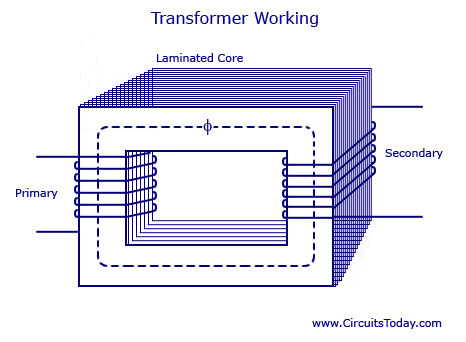Explain principle, working theory of Transformer.
Most of the electronic circuits used in Circuitstoday.com have different applications of the transformer. Therefore, it is important to know the working principle, construction and types of transformers used in different analog circuits.
Transformer Working PrincipleA transformer can be defined as a static device which helps in the transformation of electric power in one circuit to electric power of the same frequency in another circuit. The voltage can be raised or lowered in a circuit, but with a proportional increase or decrease in the current ratings.
The main principle of operation of a transformer is mutual inductance between two circuits which is linked by a common magnetic flux. A basic transformer consists of two coils that are electrically separate and inductive, but are magnetically linked through a path of reluctance. The working principle of the transformer can be understood from the figure below.

Transformer Working
As shown above the transformer has primary and secondary windings. The core laminations are joined in the form of strips in between the strips you can see that there are some narrow gaps right through the cross-section of the core. These staggered joints are said to be imbricated. Both the coils have high mutual inductance. A mutual electro-motive force is induced in the transformer from the alternating flux that is set up in the laminated core, due to the coil that is connected to a source of alternating voltage. Most of the alternating flux developed by this coil is linked with the other coil and thus produces the mutual induced electro-motive force. The so produced electro-motive force can be explained with the help of Faradays laws of Electromagnetic Induction as
e=M*dI/dt
If the second coil circuit is closed, a current flows in it and thus electrical energy is transferred magnetically from the first to the second coil.
The alternating current supply is given to the first coil and hence it can be called as the primary winding. The energy is drawn out from the second coil and thus can be called as the secondary winding.
In short, a transformer carries the operations shown below:
- Transfer of electric power from one circuit to another.
- Transfer of electric power without any change in frequency.
- Transfer with the principle of electromagnetic induction.
- The two electrical circuits are linked by mutual induction

